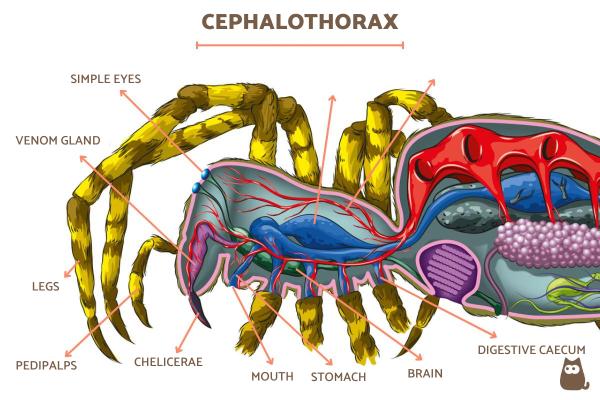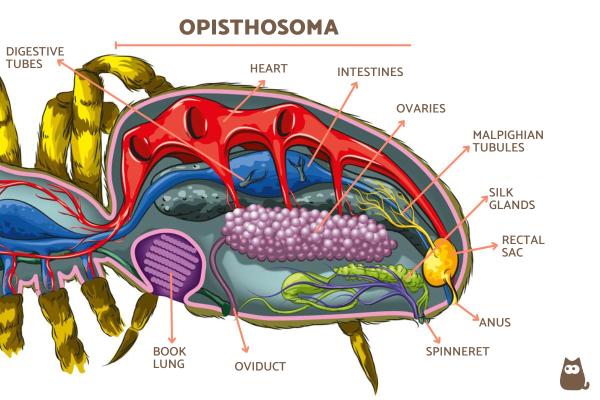
Spiders are arthropod animals that belong to the order Araneae. Within this order is a great diversity of species, being the most varied group identified as arachnids. There are many people who believe spiders are insects, but they are a different type of arthropod. Spiders have eight legs and no antennae or wings.
Spiders can be found all over the world, except in Antarctica. All are predatory and capture their prey by ambush, traps or webs where they trap and kill using venom. These arachnids vary in size, some being very tiny and others bigger than a dinnerplate. Despite their range of differences, all spiders have the same basic anatomical features. AnimalWised explains the different spider body parts with our guide to the anatomy of a spider.
Cephalothorax (prosoma)
We can generally divide the parts of a spider into two, specifically the front and the back parts. This does not include the legs which we will address separately below. The cephalothorax, also known as the prosoma, is the anterior part of spiders which many people call the ‘head’. This does not have any type of segmentation and is joined to the posterior part by a structure known as the pedicel, the equivalent to a human waist.
The cephalothorax is made up of different parts, both external and internal. We discover more about the anatomy of a spider by looking at the body parts which make up the cephalothorax:
- Simple eyes: spiders commonly have eight eyes, although this number can vary between species. Each eye has a lens, optic rods and retina. Despite such numerous eyes, their vision is poor, although some species such as hunters and jumpers can form images.
- Brain: in charge of processing the information the animal receives.
- Pumping stomach: part of the digestive system which has the function of sucking liquid food to take it to other structures of the system.
- Anterior aorta: part of the circulatory system, which is open. Unlike animals with a closed circulatory system and its accompanying veins and arteries, open systems means spider hemolymph (equivalent to blood in other animals) is mixed with interstitial fluid and travels all around the inside of their body. Through it the hemolymph is transported to the different organs of the prosoma.
- Subesophageal ganglion: connected to the brain and is involved in nerve functions.
- Coxal glands: part of the excretory system and end in the coxae of the legs, generally in the first and third pair.
- Digestive caecum: they are part of the midgut and are a series of compartments with no outlet. Although there are only a few in the cephalothorax, nutrients are extracted from food here.
- Venom gland: structure specialized in the production of toxic substances. With only very minor exceptions, all spiders have venom[1]. The strength varies incredibly and most are not harmful to large animals such as humans.
- Chelicerae: a pair of appendages with one joint and two sections. Its distal end has fangs, which many spider species use to inject venom.
- Mouth: located just after the chelicerae and is attached to the esophagus.
- Pedipalps: correspond to the second pair of appendages, similar to the legs, but shorter. They are not used for locomotion. They are used as an extension of the mouth and in males it also has a reproductive function to transfer sperm.
- Legs: we will see them in more detail below.
Learn more about different spider species with our article on the most venomous spider in the world.

Opisthosoma or (abdomen)
More commonly known as the abdomen, the opisthosoma is the posterior part of the spider's anatomy. As stated above, it is connected by a kind of waist known as a pedicel. This allows the abdomen of the spider's body to have mobility on all sides when weaving their webs.
To learn more about this body part of spiders, we look at its constituent parts:
- Glands or digestive tubes: produces digestive enzymes that the spider injects together with the venom so that predigestion of the prey occurs and they are able to suck it through the mouth.
- Ostiole: a hole that contains the heart, through which the passage of hemolymph occurs.
- Heart: tube-shaped, has no divisions and is responsible for pumping hemolymph, which replaces blood, through the arteries to the organs.
- Excretory system: it is formed by the Malpighian tubules, small structures in charge of extracting the waste in the hemolymph to be taken to the rectal sac and finally expelled through the anus.
- Silk glands: structures specialized in producing a type of protein that constitutes the silk with which they form their typical cobwebs.
- Spinnerets: modified appendages and organs made up of many microtubes that connect to silk glands. Through these microtubes the spiders expel the silk to weave their web with which some cover their dens or trap their prey.
- Reproductive system: females have an oviduct, a seminal receptacle and an ovary. Males have testicles, spermatic duct and copulatory organ, specifically the pedipalps explained in the previous section. Discover in this related article more detail on how spiders reproduce.
- Respiratory system: spiders can breathe through book lungs which are internal structures arranged in parallel chambers. They are so called as they resemble the pages of a book. Hemolymph passes through the chambers to carry out gas exchange.

Legs
One of the most important body parts of a spider's anatomy is their locomotor limbs, simply known as legs. They are all attached to the cephalothorax. These arachnids have a total of four pairs of legs, i.e. eight legs in total. Spider legs are highly articulated, as occurs in all arthropods. This allows them great flexibility, agility and precision. The following are the main segments of a spider leg:
- Coxa
- Trochanter
- Femur.
- Ball joint
- Tibia
- Metatarsus
- Tarsus
- Pretarsus (where the nails are located)
As is generally the case with arthropods, the legs of spiders have a series of segments to facilitate the mobility of the animal. Since they lack the bone structure of vertebrate animals, these limbs have developed to be able to carry out a wide range of movements. They are flexible and can walk on almost any surface, even on water like the raft spider (Dolomedes fimbriatus). Spider legs also have hairs and spines which can be very diverse in terms of size.
Now you know all about spider anatomy, see how certain species use their body parts with our articles on what house spiders eat and whether camel spiders are venomous.
If you want to read similar articles to Anatomy of a Spider - Different Spider Body Parts, we recommend you visit our Facts about the animal kingdom category.
1. Rahmani, F., Banan Khojasteh, S. M., Ebrahimi Bakhtavar, H., Rahmani, F., Shahsavari Nia, K., & Faridaalaee, G. (2014). Poisonous Spiders: Bites, Symptoms, and Treatment; an Educational Review. Emergency (Tehran, Iran), 2(2), 54–58.
https://www.ncbi.nlm.nih.gov/pmc/articles/PMC4614586